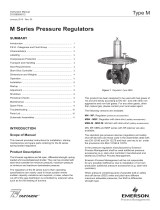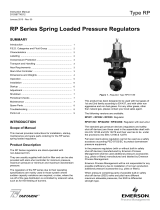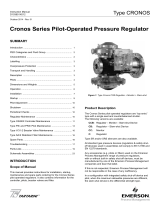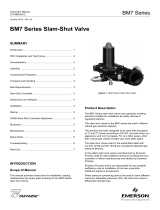Page is loading ...

CONTENTS
Cert. Version · Edition 01.23 · EN · 03250885
DE, EN, FR, NL, IT, ES, DA, SV, NO, PT, EL, TR, CS, PL, RU, HU – www.docuthek.com
Safety shut-off valve JSAV50–100
1 Safety ................................1
2 Checking the usage .....................2
3 Installation ............................2
4 Connecting the impulse line ...............3
5
Connecting the breather line ...............3
6 Tightness test..........................3
7 Checking the function....................4
8 Setting the trip pressure ..................4
9 Replacing the spring ....................4
10 Resetting ............................5
11 Replacing the measuring unit .............5
12 Replacing the valve plate ................5
13 Maintenance..........................6
14 Spare parts...........................6
15 Accessories ..........................6
16 Technical data ........................7
17 Designed lifetime ......................7
18 Certification ..........................7
19 Logistics .............................8
20 Disposal .............................8
1 SAFETY
1.1 Please read and keep in a safe place
Please read through these instructions
carefully before installing or operating. Following the
installation, pass the instructions on to the operator.
This unit must be installed and commissioned in
accordance with the regulations and standards in
force. These instructions can also be found at www.
docuthek.com.
1.2 Explanation of symbols
1, 2, 3, a, b, c = Action
➔= Instruction
1.3 Liability
We will not be held liable for damage resulting from
non-observance of the instructions and non-com-
pliant use.
1.4 Safety instructions
Information that is relevant for safety is indicated in
the instructions as follows:
DANGER
Indicates potentially fatal situations.
WARNING
Indicates possible danger to life and limb.
CAUTION
Indicates possible material damage.
All interventions may only be carried out by qualified
gas technicians. Electrical interventions may only be
carried out by qualified electricians.
1.5 Conversion, spare parts
All technical changes are prohibited. Only use OEM
spare parts.
OPERATING INSTRUCTIONS

JSAV50–100 · Edition 01.23
EN-2
2 CHECKING THE USAGE
Safety shut-off valve JSAV for securing downstream
controls against excess gas pressure.
This function is only guaranteed when used within
the specified limits– see page 7 (16 Technical
data). Any other use is considered as non-compliant.
2.1 Type code
JSAV Safety shut-off valve
50-100 Nominal size
T T-product
F Flange to ISO 7005
A ANSI flange
50 pu max. 5bar
/1 Over-pressure shut-off pdo
-0 No pressure test point
Z Special adjusting range
2.2 Part designations
5
7
8
6
9
3
4
2
1
10
11
1 Measuring unit
2 Screw plug with position indicator
3 Connection for impulse line (closed with plastic
plug)
4 Input
5 Output
6 Arrow of direction of flow
7 Reset
8 Arrow of direction of reset
9 Reset lever
10 Connection for breather line (closed with plastic
plug)
11 Valve plate
2.3 Type label
Max. inlet pressure, upper trip pressure pdo, ambi-
ent temperature: see type label.
Elster GmbH, Germany
JSAV
TS=
Pu max:
Who:
pdo:
AGo: +/- 10%
3 INSTALLATION
CAUTION
Incorrect installation!
Please observe the following to ensure that the
unit is not damaged during installation and oper-
ation:
– Sealing material and dirt, e.g. thread cuttings,
must not be allowed to get into the housing.
– We recommend installing a filter upstream of the
valve in order to protect it against impurities in
the pipe.
– Dropping the device can cause permanent
damage. In this event, replace the entire device
and associated modules before use.
– Do not clamp the unit in a vice or use it as a
lever. Risk of external leakage.
➔The installation location must be dry.
➔Check max. inlet pressure pumax..
➔Install the unit in the pipe free of mechanical
stress.
➔Installation in the vertical or horizontal position,
never upside down.
➔The housing must not be in contact with mason-
ry. Minimum clearance 20mm (0.78"). Ensure
that there is sufficient space for installation and
adjustment.
1 Remove adhesive foil from the inlet and outlet on
the JSAV.
2 Insert seal between pipe and unit.

JSAV50–100 · Edition 01.23
EN-3
3 Note direction of flow.
4 We recommend installing a manual valve AKT25
in the pipe leading to the safety relief valve
VSBV25, so that the annual function check of
the safety shut-off valve JSAV can be carried out
without having to remove it.
5 To prevent the VSBV from being unintentionally
shut off, we recommend removing the manual
valve lever after commissioning and attaching it
to the pipe.
4 CONNECTING THE IMPULSE LINE
➔Ensure that there is sufficient tube length for the
impulse line.
1 Remove the plastic plug in the impulse line
connection.
2 Connect an Rp¼ (¼NPT) pipe. We recommend
a pipe diameter of 12x1.5mm.
3 Install the impulse line and seal with approved
sealing material.
0
Rp ¼ (¼ NPT)
5
CONNECTING THE BREATHER LINE
1 Remove the plastic plug in the breather line
connection.
2 Connect an Rp¼ (¼NPT) pipe. We recommend
a pipe diameter of 12x1.5mm.
3 Install the breather line and seal with approved
sealing material.
➔Route the breather line to a safe area.
0
Rp ¼
(¼ NPT)
6 TIGHTNESS TEST
WARNING
Leaks!
Please observe the following to ensure that no
damage occurs:
– If gas-filled spaces have been opened for
maintenance work or replacement of spare
parts, an additional tightness test must be
carried out on the affected joints.
➔Ensure that the valve seat of the JSAV is open,
see page 5 (10 Resetting).
1 Block the pipeline at the inlet and outlet.
2 Note max. test pressure. JSAV inlet and outlet:
max. 7.5bar (109psig), impulse line:
max.750mbar (10.9psig).
3 Slowly apply test pressure.
0
pdo
pd
4 5
6 7

JSAV50–100 · Edition 01.23
EN-4
7 CHECKING THE FUNCTION
7.1 Checking the trip pressure
The JSAV is checked for the required trip pres-
surepdo.
1 Vent the system.
2 Ensure that the valve seat of the JSAV is open,
see page 5 (10 Resetting).
3 Close all manual valves at the inlet and outlet,
and in the breather line.
CAUTION
Please observe the following to ensure that the
regulator is not damaged during the function
check:
– Do not exceed the maximum outlet pressurepd
of the regulator.
4 Increase the outlet pressure pd on the regulator
until the required trip pressurepdo is reached.
0
pdo
pd
➔The JSAV closes at the set trip pressurepdo. The
red “SHUT” mark is visible.
5
klack
6
0
➔The JSAV has closed successfully: to restart the
system, the JSAV must be opened again, see
page 5 (10 Resetting).
➔The JSAV does not close at the required trip
pressure pdo and must be readjusted, see page
4 (8 Setting the trip pressure).
7.2 Checking the tightness of the valve plate
1 Ensure that the JSAV and outlet gas line are
closed.
2 Vent the system.
3 Slowly open the manual valve at the inlet.
4 The outlet pressure pd must not rise.
8 SETTING THE TRIP PRESSURE
1 Select the trip pressure pressure pdo according
to the outlet pressurepd of the pressure
regulator.
20
0
40 60 80 100 140 180 220 260 300 340
50
100
150
200
250
300
350
400
450
500
p
d [mbar]
p
do
[mbar]
VSBV
JSAV
2 Remove the screw plug.
➔Set the trip pressure pdo according to the
diagram.
3 4 5
+ –
➔If the JSAV has tripped, i.e. the “SHUT” mark is
visible, reset it, see page 5 (10 Resetting).
6 Check the required trip pressure pressure pdo
again, see page 4 (7 Checking the function).
7 If the JSAV has been adjusted correctly, follow
the reverse procedure when reassembling.
9 REPLACING THE SPRING
➔Various trip pressure ranges can be achieved by
using different springs on the JSAV.
1 Choose a spring according to the required trip
pressure range.
Spring table for JSAV50–100../1
Upper trip pressure
pdo Marking Order No.
35–70mbar
0.51–1.02psig light blue 03089063
60–1701) mbar
0.9–2.5psig
reddish
brown 03089064
120–220mbar
1.74–3.2psig violet 03089065
190–400mbar
2.8–5.8psig
orange/
yellow 03089066
330–550mbar
4.35–8psig
orange/
green 03089067
1) Standard spring

JSAV50–100 · Edition 01.23
EN-5
2 3 4
5 6 7
+ –
8 Adjust the required trip pressurepdo, see page
4 (8 Setting the trip pressure).
9 Follow the reverse procedure when reassembling.
10 After inserting the spring, take the spring’s label
from the packaging and stick it below the type
label on the JSAV.
11 Clearly mark the adjusted value of the trip
pressurepdo on the sticker.
10 RESETTING
The interlock is released by means of pressure
equalization so that the closed JSAV can be reo-
pened.
1 Ensure that the impulse line is depressurized.
CAUTION
Please observe the following to ensure that the
JSAV is not damaged during resetting:
– Turn the reset lever gently and do not go further
than specified.
2 Press the reset lever and turn through 10° until
resistance can be felt.
3 Hold the reset lever in this position until the lever
can be easily turned further following pressure
equalization.
4 Press and turn the reset lever until the valve plate
opens and clicks into place and the “SHUT”
mark is no longer visible.
➔The red “SHUT” mark must not be visible once
the valve plate has clicked into place.
➔The JSAV is ready for operation.
11 REPLACING THE MEASURING
UNIT
The measuring unit has to be replaced if the JSAV
no longer opens or can no longer be reset.
➔We recommend cleaning the O-ring seats and
lightly greasing the O-rings with Klüber Nontrop
ZB91DIN before installation.
1 Depressurize the system.
➔The measuring unit is supplied with 1O-ring and
4screws.
2 Ensure that the JSAV is closed. The red “SHUT”
mark must be visible.
➔If the JSAV is open, apply pressure to the im-
pulse line to close the valve.
3 Detach the impulse and breather lines from the
JSAV.
4 5 6
7 Install the new O-ring in the housing.
8 Follow the reverse procedure when reassembling.
9 Connect the impulse and breather lines to the
JSAV.
10 Check tightness and function, see page 3 (6
Tightness test) and page 4 (7 Checking the
function).
12 REPLACING THE VALVE PLATE
➔The valve plate has to be replaced if the JSAV
is leaking or if it has been damaged during
resetting.
➔We recommend cleaning the O-ring seats and
lightly greasing the O-rings with Klüber Nontrop
ZB91DIN before installation.
1 Depressurize the system.
➔We also recommend replacing the entire seal set
and the bellows when replacing the valve plate.
➔The seal set with bellows is available separately
as a spare part.
➔Ensure that the JSAV is closed. The red “SHUT”
mark must be visible.
➔If the JSAV is open, apply pressure to the im-
pulse line to close the valve.
2 Detach the impulse and breather lines from the
JSAV.
3 4 5
➔Press the reset lever and turn until the valve plate
is on top.

JSAV50–100 · Edition 01.23
EN-6
6 7
WARNING
Risk of injury!
The spring wire is under high stress.
– Carefully press the spring wire into the notch in
the plate as shown.
8 9 10
11 12 13
14 15 16
17
➔Use new O-rings from the seal set for the assem-
bly work.
18 Follow the reverse procedure when reassembling
using the new valve plate and the new O-rings.
➔To ensure that the valve plate is pushed onto
the seat by the spring, the spring wire must be
released from the notch in the plate and rest
against the housing wall.
19
20 Connect the impulse and breather lines.
21 Check tightness and function, see page 3 (6
Tightness test) and page 4 (7 Checking the
function).
13 MAINTENANCE
In order to ensure smooth operation, check the
function and tightness of the JSAV every year, or
every six months if operated with biogas.
➔In the case of malfunctioning, check the measur-
ing unit and valve plate and replace if necessary.
Selecting spare parts: see www.adlatus.org,
PartDetective. Replacing spare parts: see page
5 (11 Replacing the measuring unit) and
page 5 (12 Replacing the valve plate).
➔After carrying out maintenance work or replacing
spare parts, check for tightness and function,
see page 3 (6 Tightness test) and page 3
(6 Tightness test).
14 SPARE PARTS
The PartDetective web app for selecting spare parts
is available at www.adlatus.org.
15 ACCESSORIES
15.1 Position switch for remote indication
The position switch can be used for electronic
position checks.
OrderNo.: 03151185
Part designations
1
2
3
1 Position switch
2 Aluminium turned part
3 Lock nut
➔Two washers and another lock nut which are
included in the delivery are not required.
15.2 Using the position switch
1 Ensure that the JSAV is open. The red “SHUT”
mark is not visible.
2 3 4
5 6 7

JSAV50–100 · Edition 01.23
EN-7
8 Screw in the position switch until the switching
point is reached and then screw in a further half
a turn.
➔See the drawing labelled “Contacts” in the
enclosed position switch installation and con-
nection instructions for measuring the switching
point.
9 Prevent the position switch from rotating using
the fitted lock nut.
10 Wire the position switch.
➔See the drawing labelled “Contacts” in the en-
closed position switch installation and connec-
tion instructions for the electrical wiring.
11 After wiring, check for correct functioning, see
page 4 (7 Checking the function).
16 TECHNICAL DATA
16.1 Ambient conditions
Icing, condensation and dew in and on the unit are
not permitted.
Avoid direct sunlight or radiation from red-hot sur-
faces on the unit. Note the maximum medium and
ambient temperatures!
Avoid corrosive influences, e.g. salty ambient air or
SO2.
The unit may only be stored/installed in enclosed
rooms/buildings.
Ambient temperature: -20 to +60°C (-4 to +140°F).
Long-term use in the upper ambient temperature
range accelerates the ageing of the elastomer ma-
terials and reduces the service life (please contact
manufacturer).
Storage temperature: -20 to +40°C (-4 to +104°F).
Transport temperature: -20 to +60°C (-4 to +140°F).
The gas must be clean and dry in all temperature
conditions and must not contain condensate.
This unit is not suitable for cleaning with a high-pres-
sure cleaner and/or cleaning products.
16.2 Mechanical data for JSAV50–100
Gas type: natural gas, town gas, LPG (gaseous),
biogas (max. 0.02%-by-vol. H2S) = Group 1 fluids
pursuant to Directive 2014/68/EU or air.
Medium temperature = ambient temperature.
Max. inlet pressure pu: 5bar (72.5psig).
Max. test pressure for testing the JSAV:
inlet and outlet: temporarily <15min: 7.5bar
(109psig),
impulse line: temporarily <15min:
750mbar (10.8psig).
Trip pressure pdo preset at the factory: 120mbar
(46.8 "WC).
Trip pressure ranges, see page 4 (9 Replacing
the spring).
Accuracy group: AG10.
Connection for housing:
JSAV..F: PN16 flange to ISO7005,
JSAV..A: ANSI flange.
Connection for impulse and breather lines: Rp1/4
(1/4NPT).
Housing: GGG40.
Diaphragm: NBR.
Valve seat: aluminium.
Valve stem: stainless steel.
Valve plate: aluminium with vulcanized NBR seal.
17 DESIGNED LIFETIME
This information on the designed lifetime is based
on using the product in accordance with these
operating instructions. Once the designed lifetime
has been reached, safety-relevant products must be
replaced.
Designed lifetime (based on date of manufacture) in
accordance with DIN EN14382 for JSAV50–100:
10years.
You can find further explanations in the applicable
rules and regulations and on the afecor website
(www.afecor.org).
This procedure applies to heating systems. For ther-
moprocessing equipment, observe local regulations.
18 CERTIFICATION
18.1 Certificate download
Certificates – see www.docuthek.com
18.2 Declaration of conformity
We, the manufacturer, hereby declare that the
product JSAV50–100 with product ID No. CE-
0085CO0530 complies with the requirements of the
listed Directives and Standards.
Directives:
– 2014/68/EU – PED
– 2011/65/EU – RoHS II
– 2015/863/EU – RoHS III
Regulation:
– (EU) 2016/426 – GAR
Standards:
– DIN EN14382:2009
The relevant product corresponds to the tested type
sample.
The production is subject to the surveillance proce-
dure pursuant to Regulation (EU) 2016/426 AnnexIII
paragraph3.
Elster GmbH

JSAV50–100 · Edition 01.23
EN-8
18.3 UKCA certified
Gas Appliances (Product Safety and Metrology etc.
(Amendment etc.) (EU Exit) Regulations 2019)
BS EN14382:2019
18.4 Eurasian Customs Union
The products JSAV50–100 meet the technical
specifications of the Eurasian Customs Union.
18.5 REACH Regulation
The device contains substances of very high con-
cern which are listed in the Candidate List of the
European REACH Regulation No.1907/2006. See
Reach list HTS at www.docuthek.com.
18.6 China RoHS
Directive on the restriction of the use of hazardous
substances (RoHS) in China. Scan of the Disclo-
sure Table China RoHS2, see certificates at www.
docuthek.com.
19 LOGISTICS
Transport
Protect the unit from external forces (blows, shocks,
vibration).
Transport temperature: see page 7 (16 Technical
data).
Transport is subject to the ambient conditions
described.
Report any transport damage on the unit or packag-
ing without delay.
Check that the delivery is complete.
Storage
Storage temperature: see page 7 (16 Technical
data).
Storage is subject to the ambient conditions
described.
Storage time: 6months in the original packaging
before using for the first time. If stored for longer
than this, the overall service life will be reduced by
the corresponding amount of extra storage time.
20 DISPOSAL
Devices with electronic components:
WEEE Directive 2012/19/EU – Waste Electrical
and Electronic Equipment Directive
At the end of the product life (number of operat-
ing cycles reached), dispose of the packaging and
product in a corresponding recycling centre. Do not
dispose of the unit with the usual domestic refuse.
Do not burn the product.
On request, old units may be returned carriage paid
to the manufacturer in accordance with the relevant
waste legislation requirements.
© 2023 Elster GmbH
We reserve the right to make technical modifications in the interests of progress.
The Honeywell Thermal Solutions family of products includes
Honeywell Combustion Safety, Eclipse, Exothermics, Hauck,
Kromschröder and Maxon. To learn more about our products, visit
ThermalSolutions.honeywell.com or contact your Honeywell Sales
Engineer.
Elster GmbH
Strotheweg 1, D-49504 Lotte
T +49 541 1214-0
www.kromschroeder.com
Global centralized service deployment coordination:
T +49 541 1214-365 or -555
Translation from the German
FOR MORE INFORMATION
/













